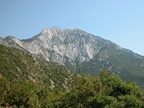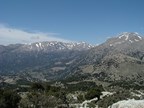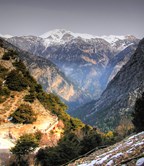Every one of us can recognize a mountain. There are geological elevations over 300m from the surface of the earth. But let’s talk with numbers: 10% of the global population lives in mountainous areas, 80% of the rivers’ springs located in mountains, the 24% of the total surface of the earth is covered by mountains and over 60% of the population lean on the mountains for water resources.
The mountains can be volcanoes, glaciers and generally rocky masses. A mountain is usually created when the lithospheric plates come to collision so from the pressure a rocky mass is getting out to the surface of the earth.
In the Greek area the ground is mainly mountainous or hilly. A big part of it, is dry and rocky, only the 20.5% can be arable. Some of the mountains in Greece are green with beautiful, full of life forests, others are naked of vegetation and others are steep and rugged with breathtaking view and natural beauties. Below you can know more about three impressive Greek mountains.
Olympus – the mountain of the gods
This list cannot be started with anything less than the Olympus Mountain. Olympus is the highest mountain in Greece with altitude 2.917m, famous worldwide mainly for its mythological story as its top Mytikas was the residence of the ‘’Olympians’’, the twelve gods of the ancient Greek religion. Olympus is the second mountain in altitude, in all the European area from the Alps to Caucasus, quite small in extent, massive and rocky, almost circular shaped with keen tops and steep slopes which create deep gorges. The tops which are more interesting if you are a climber or a geologist are three: the Mytikas top (2.917m), the Skolio top (2.911m) and the Stefani top (2.909m).
To protect the natural beauty and the special biodiversity of the mountain, since 1938 already has been declared as the first national park of Greece. Every year thousands lovers of nature visit Olympus to admire its natural fascination, to enjoy the tour in its slopes and to capture its tops. Organized, mountainous shelters offer a wide range of mountaineering and climbing routes and are available for the visitors who want to explore the mountain’s beauties. A classic starting point is the town of Litochoro located in the eastern foots of the Olympus, 100 kilometers away from Thessaloniki. There every summer ends the Olympic Mountaineering Marathon.
There are a plenty of archaeological discoveries that show the prehistoric man chose to live at the foot of the impressive mountain. In the writing of Homer Iliad, Olympus is described as magnificent, long, glorious and full of trees. From there Zeus, god of the gods was unloosing his frightful thunders showing his godly wrath. The gods had their palaces there and their meeting place was the Pantheon (modern Mytikas). This mountain has not only mythical story. When Greece was under the Turkish possession, Olympus was used as a hiding place for a team of Greek Christian illegal soldiers (something similar to rebels) who revolted against the Ottomans. Also, during the German invasion took part in the area important battles for the Greek army.
Smolikas – second in altitude but no second in beauty
Smolikas is the second of the biggest mountains in Greece with altitude 2.637m and located in the northwestern part of Greece. Essentially, Smolikas is an extension of the Pindos Chain Mountains. This mountainous mass is one of the most charming, underpopulated and difficult accessible areas in Greece. Maybe the reason of this beauty is exactly the feeling you are in an extensive place with small human presence. Something like ‘’into the wild’’. Under the mountain’s highest top, the Mossia, located the Dragon Lake, an alpine lake. Its name comes from local folktales which mentioned this lake as dragons’ habitat.
Smolikas is a mountain which offers plenty of contrasts both as flora (black pines, Bosnian pine and beeches) and ground morphology (normal tablelands, beautiful valleys, ‘’lunar’’ landscapes and deep canyons). Combines the sweet harmony with the impressive majesty. It is ideal for mountainous walking and contact with the nature.
Parnassus – the historic mountain
Parnassus has altitude 2.457m and is the most historical mountain in Greece. Its name is a pre-Hellenic word which travels us almost 4000 years ago in the 2000 BC. According to the Greek mythology, the top of Parnassus, Liakoura, is the place on which stood the ark of Deykalion and Pyrra who born Hellene, the founder of the Greeks. The mountain is close connected with the Greek History and mythology, mainly for the ‘’Delphic Sibyl’’ which is built on it. Until today, Parnassus and Delphi is a hot destination for thousands of tourists. The mountain was dedicated to the god Apollo and on it were living the Muses. Also, Parnassus was a key-location for the Greek Revolution of the 1821 as why there took part two of the most important battles: the Alamana’s and the Gravia’s battles.
Since 1938, the mountain is national park with gorgeous forests of firs, black pines and cedars. Parnassus hosts a wide range of fauna as wolves, foxes, ferrets, squirrels, eagles, vultures, falcons, boars and snakes. The underground of the mountain is very rich in bauxite deposits.
Parnassus is ideal destination for holidays for people who love mountains and good life. It is a combination of untouched beauty and places full of life like the Arahova’s ski resort. Impressive canyons, rocky tops, traditional villages, tasteful Greek dishes and many mountainous routes make this mountain unique. Also, its location is very easy to reach as why is in Central Greece, in small distance from Athens, Patra and Lamia.




